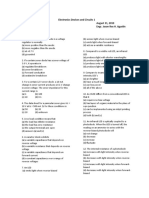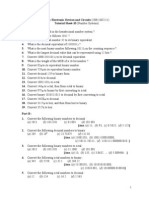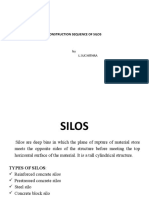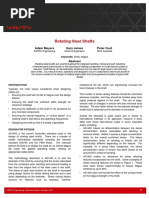Tutorial Sheet - 5 (BJT)
Uploaded by
Sulabh KumarTutorial Sheet - 5 (BJT)
Uploaded by
Sulabh KumarBasic Electronic Devices and Circuits (10B11EC211) Tutorial Sheet -5 (BJT)
1. A BJT is connected in common-base configuration and is biased such that IE = 2 mA. f its dc a!"ha is 0.#$% ca!cu!ate the &a!ues of co!!ector current IC and base current IB 'Ans. IC = 1.#( mA% IB = )0 *A+ n a gi&en transistor circuit% the base current is 100 *A and the co!!ector current is 2.# mA. Ca!cu!ate the dc a!"ha (,0) of the transistor. 'Ans. ,0 = 0.#-+ A BJT is connected in CB configuration. t is biased such that IE = 2mA. f its dc a!"ha (,0) is 0.#$.% ca!cu!ate the co!!ector current and the base current. 'Ans. IC = 1.#- mA% IB = /0 *A+ A transistor in a circuit is connected in CE configuration. The dc &o!tages are such that IB = )0 *A. f the dc beta (00) of the transistor is $0 and the co!!ector !ea1age current ICB2 is . *A% ca!cu!ate the &a!ue of emitter current. 'Ans. /.(). mA+ 3or a transistor connected in CB mode% , 0 = 0.##.% IE = 10 mA% !ea1age current IC2 = 0.. *A. 4etermine the &a!ues of the co!!ector current IC and the base current B. A!so determine 00 and ICE2 for the transistor. 'Ans. IC = 0.#.0. mA% IB = )#.. *A% 00 = 1##% ICE2 = 100 *A+ A transistor ha&ing 0 = 1)0 is connected in a circuit in CE configuration. ts co!!ector current is . mA and base current is /. *A. Ca!cu!ate the !ea1age current IC2 'Ans. IC2 = 0.-1 *A+ A transistor has ICB2 = 0.1 *A and ICE2 = 1( *A. 3ind its 0 0.##/-.+ 'Ans.
2. 3.
4.
5.
6.
7. .
n a certain transistor% ##.. 5 of the carriers in6ected into the base% cross the co!!ector-base 6unction. f the co!!ector !ea1age current is ..0 *A and the co!!ector current is 22 mA% find (a) the e7act &a!ue of ,0, (b) the emitter current% and (c) the a""ro7imate &a!ue of ,0 8hen ICB2 is ignored. 'Ans. (a) 0.##.9 (b) 22.10..mA9 (c) 0.##.2+ The dc a!"ha (,0) of a transistor is 0.## and its co!!ector re&erse !ea1age current is / *A. 4etermine the &a!ue of co!!ector current and base current% if the emitter current is ) mA. 'Ans. /.#(/ mA% /- *A+ The emitter current in an :;: bi"o!ar 6unction transistor is $.$ mA. t is 1no8n that on!< 0.$. 5 of the minorit< carriers (e!ectrons) in6ected into the base recombine% and the co!!ector re&erse !ea1age current is 200 nA. 3ind ( a) the base current% (b) the co!!ector current% (c) the e7act &a!ue of dc a!"ha% and ( d) the a""ro7imate &a!ue of dc a!"ha% neg!ecting ICO. 'Ans. (a) -).$ *A9 (b) $.-2.2 mA9 (c) 0.##1)--9 (d) 0.##1.+ A BJT has ,0 = 0.#$- and ICB2 = .2 nA. 3ind (a) 0 and ICE2, (b) the e7act co!!ector current 8hen IB = )0 *A% (c) a""ro7imate co!!ector current% neg!ecting the co!!ector !ea1age current. 'Ans. (a) -..#2%) *A9 (b) /.0)0$ mA9 (c) /.0/($ mA+
!.
1".
11.
12.
=hen the emitter &o!tage of a transistor connected in CB configuration is changed b< 200 m >% its emitter current changes b< . mA. Ca!cu!ate the d<namic in"ut resistance of the transistor. 'Ans. ri = )0 ?+ mA. n the circuit sho8n in 3ig. 1% find ( a) IC 8hen VCB = 10 >% and (b) VCB 8hen IC = 1.) 'Ans. (a) 1..1. mA9 (b) 10./$ >+
13.
#i$. 1
#i$. 2
#i$. 3
#i$. 4
14. 4etermine the coordinates of the o"erating "oint of the fi7ed-bias circuit of 3ig. 2. @i&enA RC = 1 1?% RB = 100 1?% 0 = (0. 'Ans. () >% ( mA)+ 15. n the circuit of 3ig. )% the NPN si!icon transistor has its VBE = 0.( >% and 0 = 100. f VCE = - > for RC = ) 1?% find RB and IC. 'Ans. -(. 1?% 1.-. mA+ 16. The NPN transistor used in a fi7ed-bias circuit has 0 = 100. f VCC = 10 >% RC = 1 1?% and RB = 200 1?% ca!cu!ate VCE. 'Ans. . >+ 17. A ;:; transistor 8ith 0 = 200 is used in the circuit of 3ig (./#. A dc su""!< of # > and RC of 1.. 1? are used. The o"erating "oint is to be fi7ed at IC = 2 rnA. Ca!cu!ate the &a!ue of RB and the &o!tage VCE. 'Ans. #00 1?% B( >+ 1 . A ;:; germanium transistor 8ith 0 = 100 and VBE = 0.2 > is used in 3ig. .. f VCC = 1( >% RB = -#0 1?% RC = . 1?% com"ute the Q-"oint. 'Ans. VCE = B( >% IC = 2 mA+ 1!. 4etermine the Q-"oint for a fi7ed-bias circuit using an :;: transistor 8ith 0 = )0% VCC = # >% RC = 1 1? and RB = 100 1?. 'Ans. ..) >% /.( mA+ 2". 4etermine the Q-"oint for the co!!ector-to-base bias circuit of 3ig. (% if VCC = 12 >% RC = / 1?% RB = (0 1?% and 0 of the transistor is (0. gnore the dro" VBE. 'Ans. / >% / mA+ 21. Com"ute the &a!ue of RB in 3ig. .% so as to set u" the biasing condition such that VCE = 0..VCC, if VCC = /0 >% RC = . 1?% and 0 = )0. 'Ans. 200 1?+ 22. n the co!!ector to base bias circuit of 3ig. .% VCC = 1. >% RC = . 1?% RB = 21. 1?% 0 = 100% VBE = 0.- >. (a) 4etermine the Q-"oint. (b) f the transistor is re"!aced b< another one 8ith 0 = /00% again determine the Q-"oint. 'Ans. (a) VCE = . >% IC = 2 mA9 (b) VCE = 2.. >% IC = 2.. mA+
#i$. 5
#i$. 6
#i$. 7
23. n the biasing circuit of 3ig. (% VCC = # >% RC = 2.0 ?% RB = .0 1?% RE = .00 ? and 0 = $0. 4etermine the Q-"oint. 'Ans. / >% $ mA+ 24. Com"ute the Q-"oint of the transistor in 3ig. (% if VCC = 20 >% RC = 2 1?% RB = )00 1?% RE = 1 1? and 0 = 100. 'Ans. $ >% ) mA+ 25. The :;: transistor in the biasing circuit of 3ig ( has 0 = .( and VBE = 0.- >. 4etermine its Q-"oint% if VCC = 1$ >% RC = .00 ?% RB = .0 1?% RE = 0.-. 1?. 'Ans. )./1 >% 10.#. mA+ 26. The dc current gain in CE mode of a germanium BJT is 100. t is to be biased at IC = . mA and VCE = /.$ >% b< using the emitter resistor bias circuit of 3ig. (. f VCC = 10 > and RC = .00 ?% ca!cu!ate the &a!ues of RB and RE needed. 'Ans. RE = -)0 ?% RB = 120 1?+ 27. =ith the fo!!o8ing circuit com"onents and BJT s"ecifications for the "otentia! di&ider biasing circuit of 3ig. -% ca!cu!ate the co!!ector current and the co!!ector-to-emitter &o!tage. Ca1e necessar< assum"tions to sim"!if< ca!cu!ations. RC = . 1? D! = )0 1? VCC = 12 > RE = 1 1? D2 = . 1? 00 = (0 VBE = 0./ > 'Ans. IC = 1 mA% VCE = ( >+ 2 . n the abo&e Euestion% ma1e use of The&eninFs theorem to find the accurate &a!ues of the co!!ector current and the co!!ector-to-emitter &o!tage. 'Ans. IC = 0.#/ mA% VCE = (.)2 >+
You might also like
- Question Bank - Principles of ElectronicsNo ratings yetQuestion Bank - Principles of Electronics13 pages
- range from 0.95 to 0.99 or greater, but α: DC DCNo ratings yetrange from 0.95 to 0.99 or greater, but α: DC DC5 pages
- Electronic Devices 9th Edition - CHP 5 Basic ProblemsNo ratings yetElectronic Devices 9th Edition - CHP 5 Basic Problems5 pages
- ELEX 1610 - Problems Set 9 - BJTs TransistorsNo ratings yetELEX 1610 - Problems Set 9 - BJTs Transistors4 pages
- CGPDTM 2023 - Mains Physics - Mock-4 - ElectronicsNo ratings yetCGPDTM 2023 - Mains Physics - Mock-4 - Electronics7 pages
- Basic Electronics Question Bank-2023-DecNo ratings yetBasic Electronics Question Bank-2023-Dec10 pages
- Electronics Engineering: (Model Examination)No ratings yetElectronics Engineering: (Model Examination)10 pages
- One PN Junction 2. Two PN Junctions 3. Three PN Junctions 4. Four PN JunctionsNo ratings yetOne PN Junction 2. Two PN Junctions 3. Three PN Junctions 4. Four PN Junctions17 pages
- 9991_EC21201_BASIC ELECTRONICS_2024_autumn_midsemNo ratings yet9991_EC21201_BASIC ELECTRONICS_2024_autumn_midsem4 pages
- II B. Tech I Semester, Regular Examinations, Nov - 2012 Electronic Devices and CircuitsNo ratings yetII B. Tech I Semester, Regular Examinations, Nov - 2012 Electronic Devices and Circuits4 pages
- Electronics Devices and Circuits 1 Figueroa, Raed A. August 31, 2010 B.S. Cpe Engr. Jason Rex H. AgustinNo ratings yetElectronics Devices and Circuits 1 Figueroa, Raed A. August 31, 2010 B.S. Cpe Engr. Jason Rex H. Agustin4 pages
- Chapter 3: Solid-State Diodes and Diode CircuitsNo ratings yetChapter 3: Solid-State Diodes and Diode Circuits17 pages
- ANALOG ELECTRONICS CIRCUIT-ELE-ETC-3rd-21-22No ratings yetANALOG ELECTRONICS CIRCUIT-ELE-ETC-3rd-21-222 pages
- Lab Task Solution For Electronic Devices & CircuitsNo ratings yetLab Task Solution For Electronic Devices & Circuits24 pages
- VSC-FACTS-HVDC: Analysis, Modelling and Simulation in Power GridsFrom EverandVSC-FACTS-HVDC: Analysis, Modelling and Simulation in Power GridsNo ratings yet
- Power System Transient Analysis: Theory and Practice using Simulation Programs (ATP-EMTP)From EverandPower System Transient Analysis: Theory and Practice using Simulation Programs (ATP-EMTP)No ratings yet
- Tutorial Sheet - 7 (Feedback Amplifiers)No ratings yetTutorial Sheet - 7 (Feedback Amplifiers)1 page
- Tutorial Sheet - 8 (Sinusoidal Oscillators)No ratings yetTutorial Sheet - 8 (Sinusoidal Oscillators)3 pages
- Group I (Dilute H SO Group) - CO: (Carbonate), SO (Sulphite), S (Sulphide), NO (Nitrite) : Salt + Dil HNo ratings yetGroup I (Dilute H SO Group) - CO: (Carbonate), SO (Sulphite), S (Sulphide), NO (Nitrite) : Salt + Dil H4 pages
- Tutorial Sheet - 6 (Transistor Amplifier)No ratings yetTutorial Sheet - 6 (Transistor Amplifier)2 pages
- Presentation Construction Sequence of Silos 1503761554 305716No ratings yetPresentation Construction Sequence of Silos 1503761554 30571644 pages
- ITC571 - Emerging Technologies and Innovation: Subject CoordinatorNo ratings yetITC571 - Emerging Technologies and Innovation: Subject Coordinator17 pages
- Aspec Paper - Rotating - Steel - Shafts PDFNo ratings yetAspec Paper - Rotating - Steel - Shafts PDF3 pages
- No of List Use Construction Tools and Pieces of EquipmentNo ratings yetNo of List Use Construction Tools and Pieces of Equipment20 pages
- Method 245.7 Mercury in Water by Cold Vapor Atomic Fluorescence SpectrometryNo ratings yetMethod 245.7 Mercury in Water by Cold Vapor Atomic Fluorescence Spectrometry33 pages
- Column Plan 3: Tarlac State University Bungalow Residential Arquero, Jennel ANo ratings yetColumn Plan 3: Tarlac State University Bungalow Residential Arquero, Jennel A1 page
- EY Digital Disconnect in Mining and MetalsNo ratings yetEY Digital Disconnect in Mining and Metals12 pages
- RMAG Instruction Manual 1VAL255104-MB Rev DNo ratings yetRMAG Instruction Manual 1VAL255104-MB Rev D56 pages
- Fundamentals of Image Processing Lab Manual 2014 PDFNo ratings yetFundamentals of Image Processing Lab Manual 2014 PDF68 pages
- Böhler Ti 2 Ni T-FD: Seamless Cored WireNo ratings yetBöhler Ti 2 Ni T-FD: Seamless Cored Wire2 pages




































































































